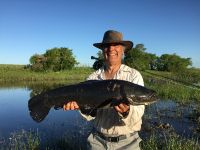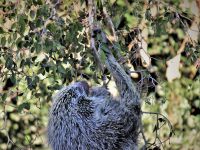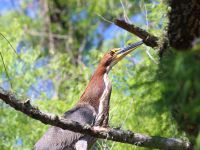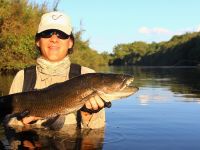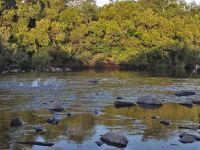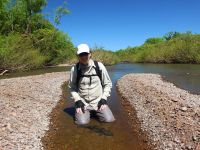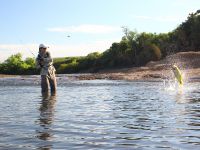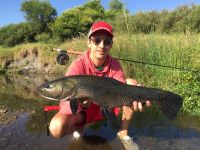How was your fishing operation in Uruguay born?
Since I was 3 years old I was fond of fishing and nature, I then evolved as a fisherman getting to know different environments and I realized that in Uruguay there was an immense potential in terms of sport fishing that was not yet exploited and that I visualized as a great opportunity. In the first place, I noticed that we could not communicate or transmit the beauty of our environments; and secondly, I always trusted in the possibility of Uruguay becoming an outstanding destination for fly fishing, world class even due to the possibility offered by our country to fish two species of high sporting value such as the blue tararira (wolffish) and the dorado in the same waters, crystalline rivers and streams. It is a fishing that complements itself in a very interesting way, as we fish for dorados in the fast currents and the Tarariras in the backwaters and slower waters.
During which months of the fishing season ?
The fishing season goes from middle or end of September, depending on the arrival of spring, until the end of April and mid-May.
How do we get to the lodge?
The fishermen can arrive to the lodge and our fishing estancias by their own means in their vehicles if they wish, and have the possibility to coordinate a pick up with the Uruwild guides in any city near our fishing estancias. You can also coordinate with the Uruwild team a flight or ride from Montevideo city to any of our fishing estancias.
Can Dorado and Tararira be caught at any time of the season?
Although the Dorado can be caught throughout the year, mainly in the Uruguay River, within the fishing sites offered by our operation the season goes from mid and late September, with the arrival of spring, until late April and mid May.
This is because the Dorado begins its cycle of reproduction with the arrival of spring, going into different rivers and streams and that is where we try to catch them, in remote places with restricted access where the angler can have an intimate and interactive experience with nature.
For the Blue Tararira, the fly-fishing season extends from mid-September to the end of April and mid-May. In these months the water temperature is higher than the rest of the year (the Blue Tararira is a fish that during the winter is lethargic reducing its energy consumption). With the arrival of the heat, the blue tararira is active again and it becomes an excellent ambush hunter that dwells in most of the Uruguayan territory.
What are the best techniques to fish these territories?
Both for Dorado and Blue Tararira, the most used technique is fishing with Streamers and mainly with floating line. We can use sinking tip or intermediate lines depending on the conditions of the rivers and streams. Our fishing destinations are always characterized by the possibility of wading and we always prioritize this type of fishing.
In most cases our waters allow sight fishing, both for tarariras and dorados, so it is important to be a good observer and to know how to use the structures and the morphology of the streams themselves. It is sometimes important for both tararira and dorado fishing to be active as fishermen and keep moving instead of staying in one place for too long. Although Tararira are usually more "static" fish, ambush hunters and low in energy consumption, it is often difficult to see them in the water so it is necessary to train your eyes and be a good observer.
For the Blue Tararira, it is important to know that it doesn't always attack our flies because it needs food, but it also attacks in many occasions because of irritation, in this situation we have to put the fly in front of them several times before they decide to take the fly.
On the other hand, the dorados are fish of greater mobility and greater energy consumption, if they are in search of food they will not have hesitations in taking our fly (if the cast and presentation was correct).
On the other hand, surface fishing with poppers or mice patterns can also be a good alternative when there is little response from the fish as this technique often manages to irritate the tararira. The dorado on the other hand is more likely to eat and attack our flies on the surface.
It is important to know that surface and sub-surface flies are not to be used at all times, but they are an excellent option to have in our fly boxes in the late afternoon or after big rains.
Finally, something very important to take into account is that due to the hardness and bone structure of both the Tararira and the Dorado, the hooking of the fish must always be done with the line in hand and not with the rod, since it is often difficult to secure the hook in the mouth of these fish.
Are the fish more cautious due to the transparency of the water?
No doubt this is a factor to be taken into account. Although all anglers like to have excellent visibility in the water, many times this is a great challenge for the angler. Both with the blue tararira and in the dorado, it may happen that the fish notices our presence, starts swimming in a "nervous" way and are hesitant to take the fly, or do not even want to take it.
In these situations it is important to keep a greater distance from the fish, offer a better presentation and many times even change our steel leader for a fluorocarbon one. The word cautious is a word that defines very well our blue Tararira, that besides being a fish of a very changeable mood and temperament, it is wary when taking our fly and it can chase flies from behind giving only small bites on its tail to inspect it.
How can we access the different spots in the river?
Each river or stream has its own particular logistics, given its geomorphology and water volume. Some spots require navigation with aluminum boats, while other streams or rivers are more suitable for small boats such as canoes with small engines.
For the more adventurous and for those places where it is difficult to even drag a small boat, another excellent option is fishing in a float tube or belly boat, downstream.
But there are multiple fishing spots that are 100% suitable for wading and can be fished for a whole day only by wading. All these different environments and factors are taken into account according to the preference and physical aptitudes of the fishermen.
What is the ideal gear for these waters and fish?
For blue tararira and dorado fishing in Uruguay it is advisable to bring a 6wt rod to fish some of our streams, and also a number 8 or 9 rod for bigger waters.
It is important to bring water shoes, or wading boots, clothes designed for fishing, buffs and polarized glasses for better visibility. For the removal of hooks it is necessary to have a long clip or gripper.
What flies can't be missing in our boxes?
For the Blue Tararira a fly that cannot be missed is the Andino Jiss designed by Ignacio Silva specifically for the fishing of the Blue Tararira. Then it is important to have other Andino streamers made of deer hair and craft fur. Other flies like the Deceiver or the Kinky are very good in these waters.
Poppers or mice patterns are also an excellent option. For the Tararira the combination of black with violet, blue and white or black and white, work very well. For the Dorado, combinations like Black with green, Black with orange or other striking colors, or simply black, are colors that also give great results.
What about the programmes and stays?
Even though fishermen can arrange their custom stay, the ideal is a 4-day stay. Then up to a whole week of fishing is always good as well. Those who are looking for a fishing and nature retreat can stay longer too.
Within our services we always offer the possibility of combining different rivers and fishing circuits so the number of days will depend on how many days the anglers want to come and the variety of environments and rivers they are looking to visit and fish.
As far as accommodation is concerned, we work with different estancias located in different parts of the territory and we offer local gastronomy (breakfast, lunch, afternoon snack and dinner) and non-alcoholic drinks and refreshments. Within the ranches we also offer room service and all the necessary transfers from the ranches to the fishing places, with the guides included and photography service too.
I think that the geography of Uruguay, the landscapes, the natural fields, our pastures and the endless rivers and streams that exist in our territory, transmit a tranquility and harmony that invite you to discover our territory in a very pleasant way.
Last but not least, there is a fascinating element for those who visit the countryside of Uruguay. This is the culture, the folklore and the tradition that is still strongly rooted in the deepest part of our territory. The way of life in the interior of Uruguay, the rhythm of life of the rural people, the simplicity and kindness of this people, and the tranquility with which the days and nights pass, are things that transport you to another dimension and even to another time, converting this experience into something really authentic. And it goes very well with our passion for fly fishing.
You can contact Uruwild right here: Travel.

















